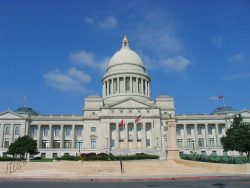
Governor Asa Hutchinson kicked off the 2018 fiscal session of the Arkansas General Assembly today with a review of his administration’s major accomplishments while outlining his priorities for the upcoming session. While there was good news to be found in his speech, there was some not-so-good news left unsaid.
Among the accomplishments he cited: a low unemployment of 3.7%; a booming state economy that is employing more people than ever before; the signing of more than 300 agreements with businesses to expand or relocate in Arkansas; and more than $7 billion in new investment and over 11,000 new jobs. The Governor noted that a growing economy, work requirements for public benefits, and improved skills training have led to benefits throughout the workforce, leading to fewer Arkansans being on Medicaid than 3 years ago and SNAP participation at its lowest rate in 9 years.
He also cited major accomplishments in education, some of which included: more than 6,000 students now taking computer science in Arkansas high schools; more than 350 schools now participating in the Reading Initiative for Student Excellence (RISE) to improve grade-level reading; the No Limits Campaign encouraging high school students to take the ACT test multiple times; and an expansion of state funding for pre-K.
During the second half of his speech, the Governor outlined his priorities for this year’s fiscal session. He proposed a budget that he claims fully funds education; reduces the rate of growth in state Medicaid spending and the use of one-time funds for ongoing Medicaid needs; meets overall state’s budget; and creates a surplus that will be used as a cushion for future economic changes while generating funding for highways. However, as AACF has previously noted, the Governor’s proposed budget does not come close to meeting important budget needs for children and families in a range of areas, including pre-K, juvenile justice, afterschool and summer school programs, targeted tax relief for low-income families (like a state Earned Income Tax Credit), and adequate funding for K-12 education and facilities, to name but a few. Nor does it come close to meeting the state’s growing infrastructure needs for highways and roads.
The major reason for current unmet needs in the budget are three successive rounds of tax cuts in 2013, 2015, and 2017 that are now reducing state revenue by nearly $300 million annually (including the Beebe tax cuts of 2013). While praising the work of the current Legislative Tax Reform and Tax Relief Task Force, the Governor unveiled his tax proposal for the 2019 session. He proposes reducing the top individual income tax rate today from 6.9 percent to 6 percent, a change that would only benefit upper-income taxpayers earning more than $75,000 in net income. For this group of taxpayers, the rate reduction would apply to net income they have greater than $35,100 (the income level at which the top rate of 6.9 percent kicks in). With an estimated cost of $180 million, this change would have huge implications for the state budget.
The rate reduction in the individual income tax would also have major implications for tax fairness, and not in a good way. It would do little to change a state and local tax system that has low- and middle-income taxpayers paying nearly 12 cents in state and local taxes on every dollar they earn, nearly double the less than 6 cents on every dollar being paid by Arkansas’s wealthiest taxpayers. The Governor’s proposal also would eliminate what little progressivity remains in the personal income tax. A reduced top rate of only 6 percent for higher-income taxpayers (incomes greater than $75,000) would equal the top rate of 6 percent currently paid by middle-class taxpayers, those with net incomes between $21,000 and $75,000 (Act 78/79 of 2017). Stay tuned for additional analyses of this proposed change in the weeks to come.

